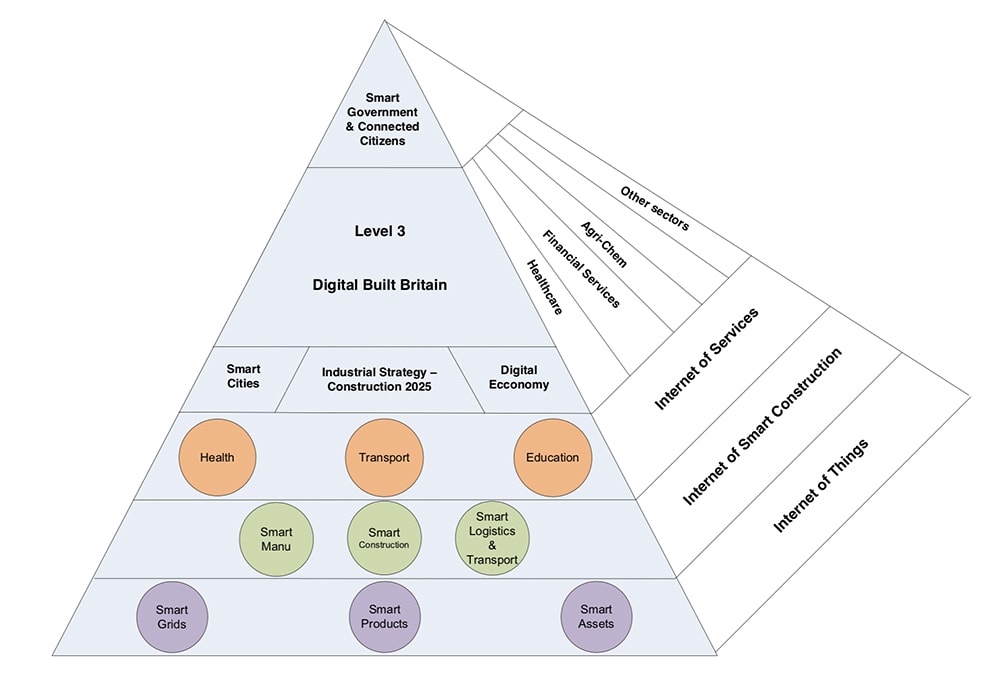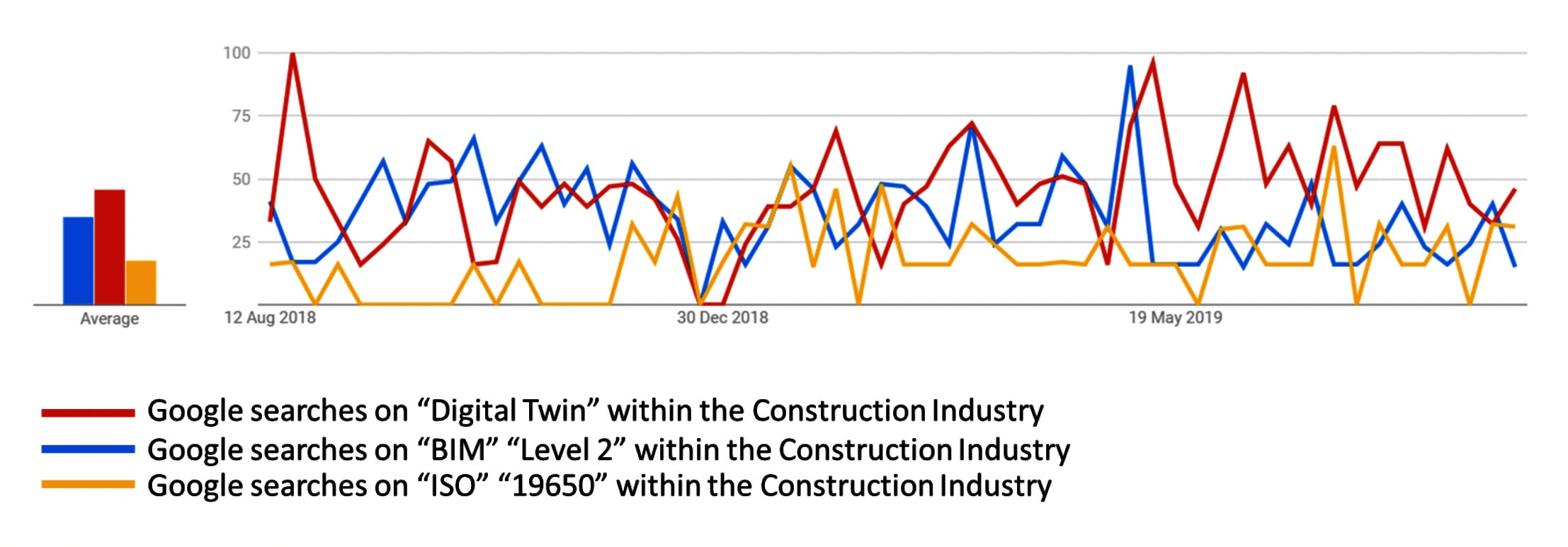In the first of a two-part article, John Ford, BIM & digital information lead at Galliford Try, dispels some of the hype around digital twins.

We have not yet, as an industry, delivered structured information consistent with the UK information standards, yet investment is now shifting to opex concepts like the digital twin.– John Ford
An industry led by promises
There is currently a lot of hype, and equally noise, about digital twins circulating the media. It is no different to when Building Information Modelling (BIM) became the focus in 2011 after the Cabinet Office took advice from the industry BIM Working Group that significant savings could be made.
This resulted in a mandatory requirement for centrally procured new built assets to utilise BIM-based processes and standards on the promise that a potential 20% savings on capex could be achieved.
Today, digital twins also come with a promised potential of £7bn saving from the National Infrastructure Commission.
There is no doubt that the AEC industry is becoming more digitally enabled. However, the concept of digital twins is not dependent on AEC only. It is dependent on the various types of owners and operators being very clear on what they want, articulating that to the AEC industry and, most importantly, actually checking, using and maintaining the information they are given rather than shelving it, which I have seen far too often.
Digital twins, the new BIM Level 3 rebrand
The digital twin concept is only new by name. In 2015, the concept was discussed in the HMG 2015 “BIM Level 3” Digital Built Britain plan. The focus of this plan was to look towards digitally replicating infrastructure and assets to enable smarter decisions by clients and operators, as well as the wider eco system that could use this digitally replicated infrastructure to inform at a national scale.
The digital twin concept builds upon this original BIM Level 3 thinking, but with increased theoretical proposals for how value can be derived and how it may be approached.
The use of BIM levels by institutions and working groups has thankfully waned as they did confuse more than they enlightened, resulting in wide misinterpretation which impacted projects at a contractual and technical level. Unfortunately, their replacements, like “digital twins”, have started to result in the same confusion as many see it as being a complete 3D digital replica of physical assets, which isn’t the case.

Digital Built Britain concept from HMG 2015 "BIM Level 3" strategic plan.
The digital twin only needs to capture information that supports specific decisions and outcomes (based on the published work by the CDBB) meaning those decisions and outcomes still need a great deal of thought.
Here lies the first problem: if you don’t understand the decisions/outcomes, then you cannot define what information you need, and you will then probably fail to get the information at the time you specified. It’s not rocket science and is exactly what was said 10 years ago before the birth of PAS 1192 and the later 19650, which both state this as a fundamental.
Creating a vicious cycle?
When BIM Level 2 was quoted as the goal for public-funded projects, whereby all the projects would adopt UK specific industry standards for managing information, there was a big outcry that the basics had been skipped or forgotten. “Running before you walk” was quoted many times. The response to such claims was often: “This is a journey – it will take time”. Even before BIM Level 2 had taken off in 2016, BIM Level 3 was the centre focus of many large working groups and academic institutions, as if there was no more work to do with PAS 1192-2 adoption.
Today, there is growing evidence from yearly reports and academic surveys that we have still not reached the original expectations from the 2011 construction strategy for delivering BIM Level 2. We have not yet, as an industry, delivered structured information consistent with the UK information standards, yet investment is now shifting to opex concepts like the digital twin.
It was these poor foundations that slowed the adoption of PAS 1192-2/BIM Level 2 because it assumed those foundations were in place across the industry and solid as part of BS 1192:2007. Unfortunately, that assumption was wrong and would delay adoption for years, as those who were miles behind, tumbled over and over as they tried to run before they walked. The digital twin concept is now gathering momentum and is even being quoted as a goal in tenders, sidelining those foundations once again.

Google statistics showing industry interest growing for digital twin over foundation standards like 19650
What is the solution?
The idea of the digital twin is noble and should continue. However, our industry is AEC in nature and not operation, albeit some dilution does occur. Yet we are now seeing contractors and designers talk about how they are creating digital twins, but are they? And clients are now asking for digital twins to be handed over, but can they? There are still many organisations and individuals struggling with the basic concepts of digital working practices and still prefer working with their pocket friends: the red pen, highlighter and notebook.
The digital twin concept shall remain a concept so long as clients/owners/operators don’t get the information they need about their assets at the time they take procession. And I can assure you that in many cases they are not getting this data, nor is there a strong drive among many of them to obtain it.
A total of 11 major projects this year in which I have been involved and funded by public administrations, failed to produce a Employer’s Information Requirements at tender even though they quoted PAS 1192/ISO 19650 in their contracts. Several more projects that did, presented information requirements that didn’t reflect their actual needs.
I have several examples in the past 24 months of clients receiving digital information, but not using it themselves or handing it over to their operators. I found one reason for this was because the operator was still on a yearly renewed contract to go back out to site and collect this data themselves again, after handover, which they of course did because it’s revenue for them.
When I asked the client’s director responsible for digital transformation about this, the typical cliched response was that the problem is too big to resolve just now and the business doesn’t have time to invest in such change.
Major public, and many private clients/owners/operators, have still not made the cultural change many of us discussed a decade ago, changes necessary to define, absorb or use digital information. This means they don’t correctly define, will not receive or cannot use what information they get for perhaps many more decades, making digital twins a fantasy.
This is a national tragedy and one that doesn’t seem to be taking centre focus for resolution by any of our large industry groups, no matter the evidence, which shows the slowing momentum to transform the industry by the masses rather than the minority few that regularly attend BIM/Digital conferences and groups.
More from John Ford
Main image: Dreamstime
Comments
Comments are closed.
















Just a quick comment as author, it was meant to say 20% savings during Totex (whole life saving)
Some interesting points here which address the herd of elephants in the room! Whilst the digital twin/golden thread discussion is laudable, yet again those at the cutting edge have run off chasing hub caps and flashing lights, leaving the rest of us behind.
Meanwhile the good ol’ UK industry trundles on. Clients and supply chain, SME’s. Two main segments of industry that have huge bearing on the success of digital transformation, yet continue to be neglected.
The penny doesn’t seem to have dropped yet. Why not? The Asset Information Model, AIM, where it exists, is a lifetime commitment, to be maintained, kept up to date, to be accurate and reliable. The moment the AIM is out of date, it is useless. On a sizeable project, this is a huge commitment at the moment. But has to be driven by clients, presumably with deep pockets.
Delivery of your PIM/AIM, asset data, is only as good as your supply chain. Whilst it seems we are being discouraged from using the wedge terminology, industry can barely deliver Level 1 as it was. Much work to be done. But I wonder who is actually going to do it?
The fundamental mistake was when the focus shifted to Level 3, assuming Level 2 was a done deal. Which it STILL isn’t! But I’m not allowed to say Level 2. :o)
You are allowed to say UK BIM Framework though!
Four legs good! Two legs BETTER! :o)
Get clients and supply chain to know more about ISO 19650 first. Most of them could not even get to grips with the superseded PAS and BS documents. Most design and delivery task teams failed to set up and deliver Information in BIM correctly. The BIM coordinator role cannot simply replace the BIM team roles in the PAS documents.
I agree, we have to continue to get the industry more capable of delivering correct PIM/AIM in BIM Level 2 first before concentrating on BIM Level 3.